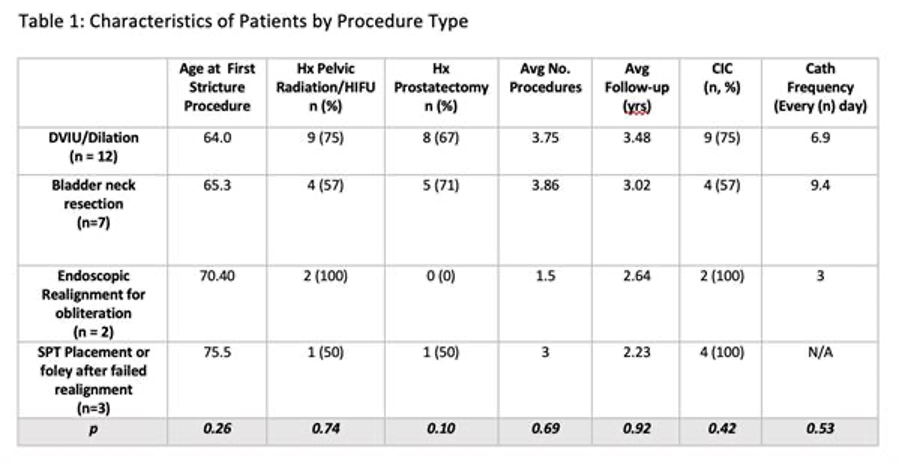Back
Poster, Podium & Video Sessions
Moderated Poster
MP22: Trauma/Reconstruction/Diversion: Urethral Reconstruction (including Stricture, Diverticulum) I
MP22-08: Less is More in the Management of Proximal Stricture Disease after Prostate Cancer Treatment
Saturday, May 14, 2022
8:45 AM – 10:00 AM
Location: Room 228
Peris Castaneda*, Kai Dallas, Los Angeles, CA, Hanson Zhao, Cleveland, OH, Jennifer Anger, San Diego, CA
- PC
Peris Rose Castaneda, MD
Resident Physician
Cedars-Sinai Medical Center, Department of Surgery, Division of Urology
Poster Presenter(s)
Introduction: Urethral stricture following treatment for prostate cancer presents unique treatment challenges due to fibrosis and radiated tissue, which renders reconstruction procedures highly morbid. As a result, minimally invasive endoscopic procedures such as TURBN, DVIU, and endoscopic realignment, are often performed. Although self-calibration after endoscopic management is often considered a “failure”, for men after prostate treatment, self-calibration often keeps the outlet open while maintaining social continence. We sought to determine long-term outcomes in men managed with endoscopic procedures followed by self-calibration and the frequency of self-calibration needed once a steady state was achieved.
Methods: A retrospective review was performed of patients with history of pelvic radiation (including brachytherapy and HIFU) or surgical treatment for prostate cancer who developed proximal urethral strictures between November 2010 and September 2020. Endoscopic realignment was performed in the case of total obliteration. Otherwise, DVIU/bladder neck resection was performed. After catheter removal, men were taught to self-calibrate with decreasing frequency until weekly calibration was achieved. After that, asymptomatic men could stop catheterizing.
Results: Twenty-one men met inclusion criteria. Average age at first treatment was 71.8 (std. 6.7). Mean follow-up time was 3.1 years. Eleven men (65%) had history of radiation therapy and 10 men (59%), history of prostatectomy. Average number of minimally invasive procedures per patient was 3.3 (std 1.6). (Table 1) Twelve patients (71%) performed self-catheterization at some point during their treatment. Catheterization frequency ranged between 5 times daily in severe cases to once every two months in the office. The average need to catheterize was once every 5.9 days. There were 3 failures of endoscopic realignment for obliteration. Six patients continue to have periodic office dilation and 5 require no dilation.
Conclusions: Minimally invasive treatments for urethral stricture are a viable option for patients with history of treatment for prostate cancer. Patients are likely to need multiple procedures. Most patients will need to self-catheterize, however self-catheterization regimens are not time-intensive.
Source of Funding: None

Methods: A retrospective review was performed of patients with history of pelvic radiation (including brachytherapy and HIFU) or surgical treatment for prostate cancer who developed proximal urethral strictures between November 2010 and September 2020. Endoscopic realignment was performed in the case of total obliteration. Otherwise, DVIU/bladder neck resection was performed. After catheter removal, men were taught to self-calibrate with decreasing frequency until weekly calibration was achieved. After that, asymptomatic men could stop catheterizing.
Results: Twenty-one men met inclusion criteria. Average age at first treatment was 71.8 (std. 6.7). Mean follow-up time was 3.1 years. Eleven men (65%) had history of radiation therapy and 10 men (59%), history of prostatectomy. Average number of minimally invasive procedures per patient was 3.3 (std 1.6). (Table 1) Twelve patients (71%) performed self-catheterization at some point during their treatment. Catheterization frequency ranged between 5 times daily in severe cases to once every two months in the office. The average need to catheterize was once every 5.9 days. There were 3 failures of endoscopic realignment for obliteration. Six patients continue to have periodic office dilation and 5 require no dilation.
Conclusions: Minimally invasive treatments for urethral stricture are a viable option for patients with history of treatment for prostate cancer. Patients are likely to need multiple procedures. Most patients will need to self-catheterize, however self-catheterization regimens are not time-intensive.
Source of Funding: None


.jpg)
.jpg)